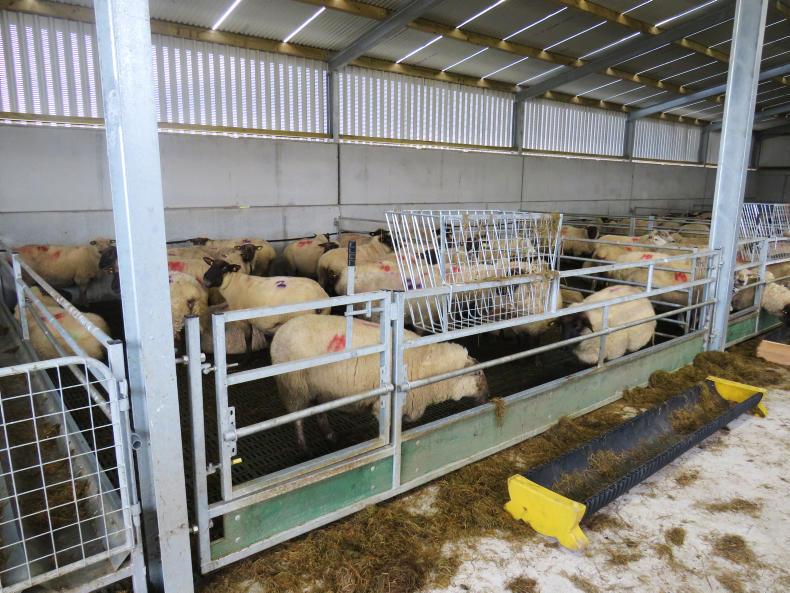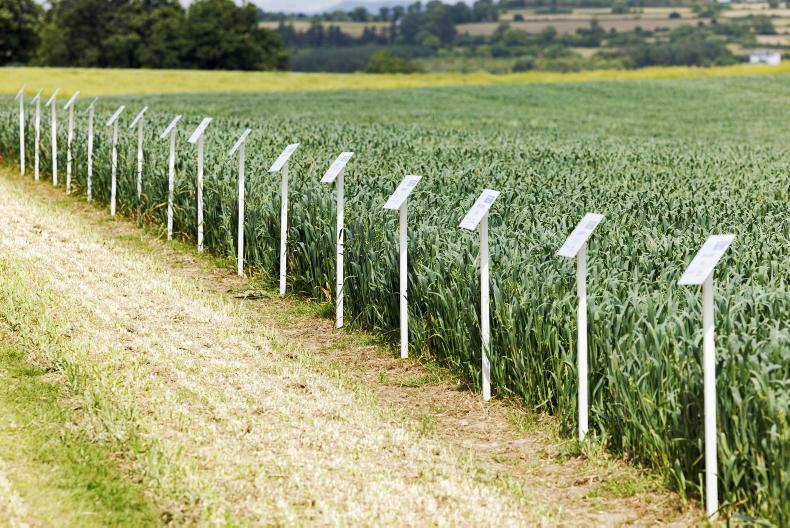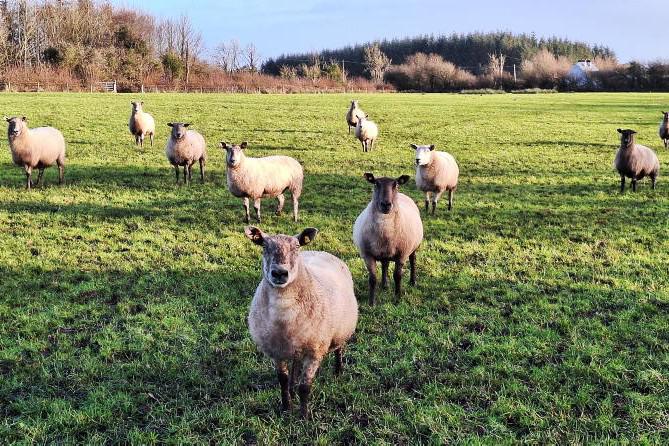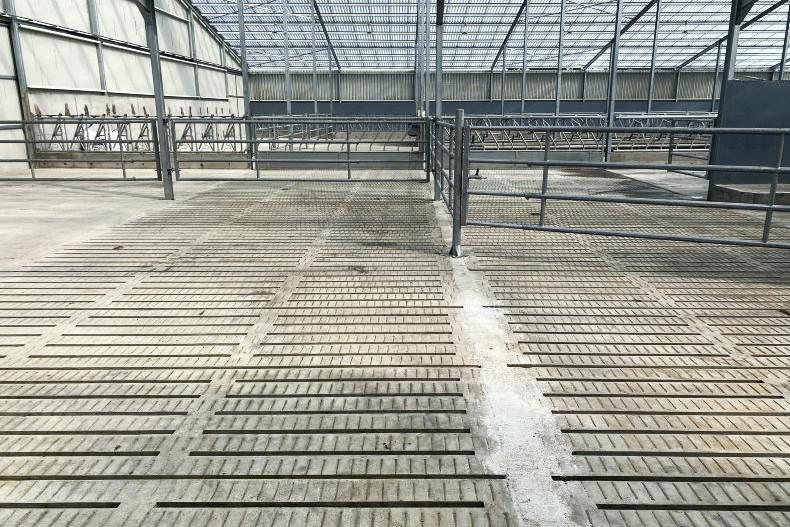Brian Boyle and his father John Joe are farming in Brownesgrove, Tuam, Co Galway. They run a flock of 170 lowland ewes and finish 90 mainly continental cattle per year.
Brian works outside the farm during the day which leaves the evenings and weekends busy, especially during the hectic spring period.
To ease the workload on the farm, the Boyles made the decision to invest in new sheep housing facilities.

Brian and John Joe pictured with x and Bernie Mangan from Cormac Sheep Equipment.
“We were lambing in an old hayshed but space was limited,” John Joe explained.
They were at the point where a new bespoke sheep shed was a necessity. When they received full planning permission they made an online application to the Department of Agriculture Targeted, Agricultural, Modernisation, Scheme (TAMS) II for a six-bay slatted sheep shed.
“I had already got the Green Cert through the online course with Mountbellew Ag College, which meant I qualified for a 60% grant towards the cost of the shed,” said Brian. This, he said, was a great incentive to make the considerable investment.
Work on the new shed started in July 2018 and was complete by Christmas of that year.
The Irish Farmers Journal recently visited the Boyles’ new sheep shed ahead of its second lambing season.
The shed
The Boyles opted to go with a 6ft deep slurry tank. It has a capacity of 299.52m3 of slurry with 200mm of freeboard and spine wall taken into account.
Some sheep sheds have shallow tanks underneath the slatted area connected to a 6ft-deep agitation point. The sheep will never fill this 6ft-deep tank up during the housing period but putting in the deep tank made sense.
For one, the cost difference between a deep slurry tank and a shallow tank is not massive because the casings still have to be erected. Labour costs remain similar, although there are modest savings in the quantity of concrete used.
Another benefit of installing a deep slurry tank is the extra slurry storage it provides, which can be a godsend during a long winter.

The large concrete tank also future-proofs the building if they ever decide to use the shed for a cattle enterprise as the plastic slats could easily be replaced with concrete slats.
Brian Connell from Headford, Galway, did all the concrete work in the shed. Interestingly, the walls in the shed were bought in precast format from O’Reilly Concrete based in Cavan. Precast walls can be moved easily in the future if needs be, which gives good flexibility for changes down the line.
“There wasn’t really any difference in cost between a mass concrete wall and precast but at least the precast can be moved in the future if we want,” said Brian.
Comfort is key
Inside the shed is bright and very comfortable for sheep. Lyons Steelwork in Moylough erected the shed. All the steel girders were hot-dipped galvanised to help improve the longevity of the building.
The plastic sheep slats were supplied by Jetwash, who are based in Carrigallen, Co Leitrim. These slats are supported underneath by steel runners that sit on top of the walls of the concrete tank.
Cormac Sheep Equipment supplied and fitted the feed barriers and the walk-through troughs. The standard barriers are 15ft 2in long and the barriers beside the walk-through trough are 12ft 6in. Each walk-through trough is 27in wide.
The Boyles also installed hayracks supplied by Peter Geoghan from Dunmore. Each pen is 4.8m wide and 6m deep with capacity for 22 in-lamb ewes.
The total housing capacity of the shed is 132 ewes.
Cost
The Boyles are very happy with how the shed turned out. They now have far more housing capacity, which makes a huge difference during the critical weeks of lambing time.
The land also gets a rest for a couple of months which allows them to build up early grass for freshly lambed ewes. During the winter this year the Boyles finished lambs in the shed also.
Brian says there is room to feed up to 200 lambs on an ad-lib meal diet when the shed is not being used for in-lamb ewes.
The total cost of the shed was €64,000 excluding VAT. They received a 60% TAMS II grant towards this cost, which left them €25,000 out of pocket for the entire build.
Bernie Mangan from Cormac Sheep Equipment says a 10ft walk-through trough costs €320 and the optional end gate costs €70. The 15ft 6in standard barrier costs €380 and the 12ft 6in barrier costs €350.
The Department of Agriculture reference cost for sheep slats is €47.30/m2. The Department’s reference cost for an entire slatted house for sheep is €161.70/m2.
Brian Boyle and his father John Joe are farming in Brownesgrove, Tuam, Co Galway. They run a flock of 170 lowland ewes and finish 90 mainly continental cattle per year.
Brian works outside the farm during the day which leaves the evenings and weekends busy, especially during the hectic spring period.
To ease the workload on the farm, the Boyles made the decision to invest in new sheep housing facilities.

Brian and John Joe pictured with x and Bernie Mangan from Cormac Sheep Equipment.
“We were lambing in an old hayshed but space was limited,” John Joe explained.
They were at the point where a new bespoke sheep shed was a necessity. When they received full planning permission they made an online application to the Department of Agriculture Targeted, Agricultural, Modernisation, Scheme (TAMS) II for a six-bay slatted sheep shed.
“I had already got the Green Cert through the online course with Mountbellew Ag College, which meant I qualified for a 60% grant towards the cost of the shed,” said Brian. This, he said, was a great incentive to make the considerable investment.
Work on the new shed started in July 2018 and was complete by Christmas of that year.
The Irish Farmers Journal recently visited the Boyles’ new sheep shed ahead of its second lambing season.
The shed
The Boyles opted to go with a 6ft deep slurry tank. It has a capacity of 299.52m3 of slurry with 200mm of freeboard and spine wall taken into account.
Some sheep sheds have shallow tanks underneath the slatted area connected to a 6ft-deep agitation point. The sheep will never fill this 6ft-deep tank up during the housing period but putting in the deep tank made sense.
For one, the cost difference between a deep slurry tank and a shallow tank is not massive because the casings still have to be erected. Labour costs remain similar, although there are modest savings in the quantity of concrete used.
Another benefit of installing a deep slurry tank is the extra slurry storage it provides, which can be a godsend during a long winter.

The large concrete tank also future-proofs the building if they ever decide to use the shed for a cattle enterprise as the plastic slats could easily be replaced with concrete slats.
Brian Connell from Headford, Galway, did all the concrete work in the shed. Interestingly, the walls in the shed were bought in precast format from O’Reilly Concrete based in Cavan. Precast walls can be moved easily in the future if needs be, which gives good flexibility for changes down the line.
“There wasn’t really any difference in cost between a mass concrete wall and precast but at least the precast can be moved in the future if we want,” said Brian.
Comfort is key
Inside the shed is bright and very comfortable for sheep. Lyons Steelwork in Moylough erected the shed. All the steel girders were hot-dipped galvanised to help improve the longevity of the building.
The plastic sheep slats were supplied by Jetwash, who are based in Carrigallen, Co Leitrim. These slats are supported underneath by steel runners that sit on top of the walls of the concrete tank.
Cormac Sheep Equipment supplied and fitted the feed barriers and the walk-through troughs. The standard barriers are 15ft 2in long and the barriers beside the walk-through trough are 12ft 6in. Each walk-through trough is 27in wide.
The Boyles also installed hayracks supplied by Peter Geoghan from Dunmore. Each pen is 4.8m wide and 6m deep with capacity for 22 in-lamb ewes.
The total housing capacity of the shed is 132 ewes.
Cost
The Boyles are very happy with how the shed turned out. They now have far more housing capacity, which makes a huge difference during the critical weeks of lambing time.
The land also gets a rest for a couple of months which allows them to build up early grass for freshly lambed ewes. During the winter this year the Boyles finished lambs in the shed also.
Brian says there is room to feed up to 200 lambs on an ad-lib meal diet when the shed is not being used for in-lamb ewes.
The total cost of the shed was €64,000 excluding VAT. They received a 60% TAMS II grant towards this cost, which left them €25,000 out of pocket for the entire build.
Bernie Mangan from Cormac Sheep Equipment says a 10ft walk-through trough costs €320 and the optional end gate costs €70. The 15ft 6in standard barrier costs €380 and the 12ft 6in barrier costs €350.
The Department of Agriculture reference cost for sheep slats is €47.30/m2. The Department’s reference cost for an entire slatted house for sheep is €161.70/m2.












SHARING OPTIONS